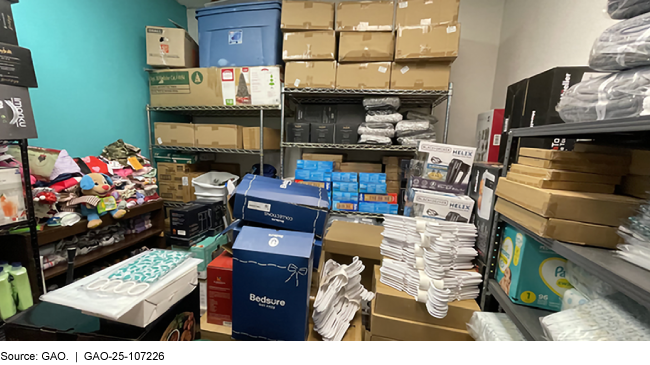Temporary Assistance for Needy Families: HHS Could Facilitate Information Sharing to Improve States' Use of Data on Job Training and Other Services
Fast Facts
States get about $16.5 billion a year for Temporary Assistance to Needy Families, a program for people and families with low incomes. States use these funds and their own to provide cash and various "non-assistance" services such as job training and child care, depending on state priorities.
In the 7 states we examined, state and local service providers use data to monitor performance, adjust services, and more.
To improve outcomes and ensure effectiveness, we recommended that the federal government work with states to improve how they use and share data on these services.
A TANF-supported center in New Mexico provides essentials to families when they find housing.

Highlights
What GAO Found
The Department of Health and Human Services' (HHS) Temporary Assistance for Needy Families (TANF) block grant funds cash assistance and certain “non-assistance” services. These services include work, education, and training activities; childcare; and child welfare services (see fig.). The seven states GAO reviewed varied in the percentage of TANF funds spent on these different services, reflecting their distinct priorities. State officials told GAO that their states often combined TANF funds with other funds, including other federal grants or state funds, to provide these services.
Overview of the Flow of Temporary Assistance for Needy Families (TANF) Non-assistance Funds from the Federal Government to State and Local Service Providers

Officials from selected states generally reported collecting various demographic, participation, and outcome data on individuals and families receiving services supported by TANF non-assistance funds. Officials reported that they used various data to make eligibility determinations, monitor program performance, and adjust the delivery of TANF non-assistance services. Service providers report some data on services funded with non-assistance to state agencies, but there are no federal TANF reporting requirements for performance information on services funded with non-assistance funds. To address this, in December 2024, GAO recommended that Congress consider granting HHS additional oversight authority and also recommended that HHS improve existing reporting requirements. For certain instances in which states used TANF non-assistance funds in combination with other federal funding streams, states and service providers were subject to other federal reporting requirements.
Officials from selected states reported that they encountered a range of challenges using data on those served with TANF non-assistance funds. These challenges sometimes hindered states' ability to assess whether the services improved participant outcomes. HHS's technical assistance initiatives have supported states' TANF data efforts. However, HHS's initiatives have focused on assistance while non-assistance has accounted for an increasingly large share of TANF spending. Officials from the selected states expressed an interest in learning from one another to improve their efforts to use data on those served with TANF non-assistance funds. By facilitating such information sharing, HHS could help states improve their oversight of non-assistance funds and their efforts to improve participant outcomes.
Why GAO Did This Study
Annually, TANF provides about $16.5 billion to states to help millions of low-income individuals and families. In fiscal year 2022, states spent more than 44 percent of federal TANF and state funds on non-assistance services. Questions have arisen about how states use and account for TANF funds. GAO was asked to review TANF non-assistance spending.
This report examines (1) how selected states have used TANF non-assistance funds, (2) non-assistance data collected and used by selected states, and (3) any data challenges faced by selected states and the extent to which HHS provides support to address these challenges. This report is part of a series of reports on TANF GAO issued in 2024 and 2025 ( GAO-25-107235 and GAO-25-107290 ).
GAO analyzed selected states' fiscal year 2022 TANF expenditure data, the most recent available at the time of GAO's analysis. GAO also interviewed HHS officials, those knowledgeable about TANF, and state and local officials in a nongeneralizable selection of seven states (Illinois, Mississippi, New Mexico, New York, Ohio, Texas, and Wyoming). These states were selected to reflect variation in geographic region and the percentage of residents in poverty. GAO reviewed relevant federal laws, regulations, and agency documents.
Recommendations
GAO is recommending that HHS facilitate information sharing among state TANF agencies on using data on non-assistance services. HHS agreed with this recommendation.
Recommendations for Executive Action
| Agency Affected | Recommendation | Status |
|---|---|---|
| Department of Health and Human Services | The Secretary of HHS should ensure the Assistant Secretary for Children and Families facilitate information sharing among state TANF agencies on promising practices for using data on those served with TANF non-assistance funds. For example, HHS could encourage states to share their experiences, including promising practices and challenges, with each other through conferences or workshops. (Recommendation 1) |
HHS concurred with this recommendation. The agency noted that, while it does not have authority to collect data on those served with TANF non-assistance funds, it will integrate conversations about these data in its regular peer-to-peer learning opportunities among state TANF agencies. In addition, the agency said it plans to include topics related to data quality and analysis in forums such as regional and national conferences and technical assistance learning opportunities. We will monitor the progress of these efforts.
|
